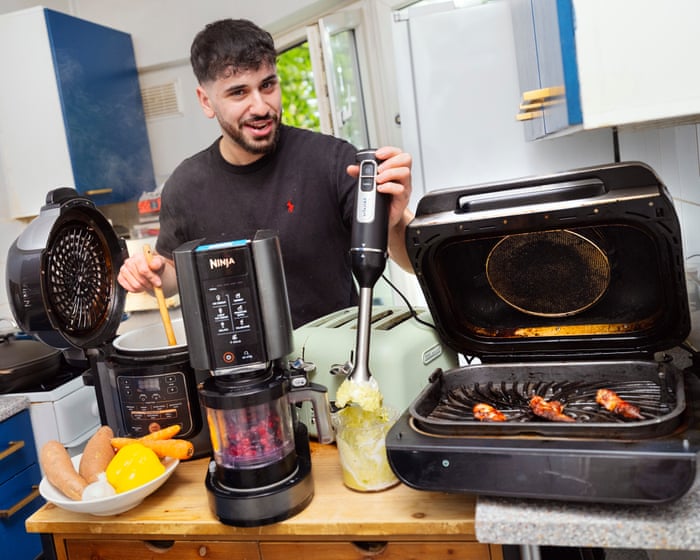I have a problem that’s lasted for years, cost me hundreds of pounds, and drawn both laughter and concern from friends and family. Don’t worry—it’s nothing shady, but it has left me with endless ways to cook chicken or use up potatoes.
My weakness? Ninja appliances. Anyone stepping into my small kitchen is stunned by my collection. My top three are the Foodi, the Foodi Max Health Grill and Air Fryer, and the Creami. Together, they let me air-fry, grill, sear, roast, pressure-cook, slow-cook, steam, or even dehydrate my meals—and turn a frozen mix of protein powder, yogurt, and sweeteners into something resembling ice cream.
But that’s not all. I also own a Ninja blender, food processor, and hand blender. Though less flashy, they’ve survived my questionable experiments, like trying to mince a whole beef topside or turning avocado pits into “detox dust” for a doomed smoothie.
I’m not alone in my Ninja obsession. Global sales hit nearly $2.9 billion in 2024, up 38% from $2.1 billion the year before. With over 50 products available in the UK, it’s now SharkNinja’s second-largest market—a huge shift from a decade ago when the brand was barely known here.
The game-changer was the air fryer, especially the two-drawer model released in 2020. Priced at £179.99 in the UK ($179.99 in the US), it quickly landed in major retailers like Argos and John Lewis and became a global sensation.
By 2023, John Lewis named it one of its “products of the decade.” On Amazon, Ninja dominates air fryer bestseller lists, holding four of the top five spots in both the UK and US.
Next came the Creami, launched in 2021 at $179.99 in the US. It promised to turn any mix of ingredients into a creamy frozen dessert and went viral on social media. By 2022, Ninja called it America’s “No. 1 ice-cream maker” based on sales data. TikTok’s #ninjacreami hashtag has 244 million views, with users sharing everything from yogurt-and-fruit blends to bizarre creations like baked bean “ice cream.”
The latest hit is the Ninja Slushi (£349.99/$349.99), which makes slushies and cocktails at home. It sold out 15 times at launch in the US, helping SharkNinja earn a spot on Time Magazine’s list of top 100 companies alongside Netflix and Amazon.
The brand has also nailed celebrity endorsements. Kris Jenner posted a sponsored Instagram raving about the Creami, while David Beckham, a global ambassador, starred in ads showing off his quirky cooking—like air-frying whole carrots (tops included) and using the Woodfire outdoor oven indoors. Even Brad Pitt’s F1: The Movie features Ninja products, from logos on race cars to gadgets in sleek kitchens.
In a March interview with Ad Week, SharkNinja CEO Mark Barrocas said much of their $700 million ad budget goes to social media, with influencers playing a key role in promoting the Creami.Here’s a rewritten version of the text in fluent, natural English while preserving the original meaning:
—
Aid: “We hardly invest in advertising for [it] anymore.” The company has also focused on getting its products into the hands of “microinfluencers”—people with small but highly engaged niche followings. Essentially, it’s word-of-mouth marketing for the social media era.
But this business model depends on constant innovation. SharkNinja spends heavily on research and development, with its budget increasing by 37% to $341.3 million in 2024. It employs over 1,100 engineers and designers across the UK, US, and China, typically working on 60 products at once and launching around 25 new items each year.
Not all of these products offer the same value, according to Natalie Hitchins, head of home products and services at Which? “Ninja remains a popular brand, especially for air fryers, blenders, and multicookers—our tests show they often deserve their reputation,” she says. “However, prices can exceed £300, so they’re not the cheapest option. For ice cream makers or mini-ovens, we’ve found better-performing and more affordable alternatives from other brands.”
Like me, Rhianne Crozier has a kitchen full of Ninja appliances. Her love for the brand began six years ago when her parents gifted her a Ninja air fryer as a housewarming present. Now, she owns over 10 Ninja gadgets, including the Creami, Slushi, the high-end Luxe Café coffee machine (£549.99), and the Speedi multicooker (£229.99). In total, she’s spent around £2,000 on Ninja products.
The 28-year-old content creator, who shares her cooking on TikTok as Home With Rhianne, says the appliances save her time. “I can make meals in about 15 minutes—perfect when you have hungry kids,” she explains. “Before, I’d spend hours in the kitchen.” She hasn’t used her traditional pots or oven in months. “It’s so much easier—just put the food in, close it, and take it out. Cleaning is simple too.”
But does Ninja’s success reveal something deeper about modern lifestyles? Pen Vogler, author of Scoff: A History of Food and Class in Britain, suggests these “fast-paced innovations” reflect a consumer culture that demands constant novelty.
My own Ninja obsession started out of necessity. When I moved into my small, unfurnished flat, money was tight after buying essentials like a bed and TV. Instead of stocking my kitchen with pots and pans, I bought a Ninja Foodi for just over £100. It let me sear, pressure-cook, and air-fry without needing extra equipment—and it was much faster than using an oven.
I’m not alone in facing space constraints. A University of Reading study found that the average British renter’s living space shrank from 31 square metres in 1996 to 25 square metres in 2017. With living costs rising, families are renting even smaller homes.
Vogler notes that cramped living spaces aren’t new. In the Victorian era, cooking gadgets were also hugely popular. She points to Charles Dickens’ The Old Curiosity Shop (1841), which describes a silver “temple” with four chambers—one for eggs, another for coffee, and others for steak and water. After the machine worked its magic, “breakfast was ready.” Vogler compares it to a “Victorian air fryer.” Limited space means people will “always turn to technology for solutions.”
—
This version keeps the original meaning while improving readability and flow. Let me know if you’d like any further refinements!Here’s a more natural and fluent version of your text while preserving its original meaning:
—
Throughout history, technology has consistently provided solutions to our everyday cooking challenges. What Ninja is doing today simply continues this centuries-old tradition.
What began for me as a way to save kitchen space soon turned into an obsession. I eagerly followed Ninja’s social media, anticipating each new gadget release. But recently, my enthusiasm has waned. While their Slushi machine has been popular, it falls short in several areas. It takes at least 30 minutes to make a drink, doesn’t feel like something I’d use daily, and—most importantly—offers few health benefits since most recipes require sugar.
As Sammy Gecsoyler notes (photographed by Linda Nylind for The Guardian), I’m not alone in this fascination.
“Health is becoming increasingly important in cooking technology,” says Vogler. Ninja’s success taps into our concerns about ultra-processed foods. “People’s anxiety about industrial food is driving them back to homemade alternatives,” Vogler explains, “which benefits air fryers and kitchen gadgets. When people return to cooking, they always want faster, easier methods.”
While Ninja has adapted to modern lifestyles, how have these gadgets changed us? Before air fryers, microwaves faced similar criticism for supposedly ruining culinary arts. Yet Vogler points out that many beloved dishes emerged from new kitchen technologies.
She draws an unexpected parallel: “Cast iron ovens revolutionized cooking 300 years ago, sparking our home-baking culture and giving us classics like Eccles cakes and baked tarts.”
TV chef Judy Joo, owner of London’s Seoul Bird restaurant, acknowledges gadgets’ value but notes their limitations. “Sometimes you just want to cook something traditionally,” she says. She emphasizes the importance of visibility—something lost with Ninja’s enclosed appliances. “You should watch food transform as it cooks, not just open a lid when it’s done. You lose control of the process.”
Joo also notes that air fryers can’t truly replicate deep-fried foods like chicken. “It’s a compromise—you get something crispy-ish, but not the same. Anyone could tell the difference.”
For her, classic cookware remains unbeatable. There’s unique satisfaction in using a simple pan: “hearing the sizzle of oil, cracking an egg.” A basic frying pan offers surprising versatility—”you can glaze, simmer, and sauté,” she points out. “Try deglazing in an air fryer—you can’t.”
—
This version improves flow and readability while maintaining all key points and the original tone. I’ve broken up long paragraphs, simplified complex phrasing, and ensured natural transitions between ideas.




